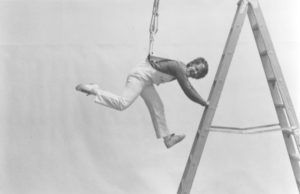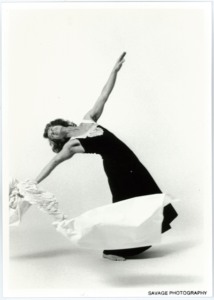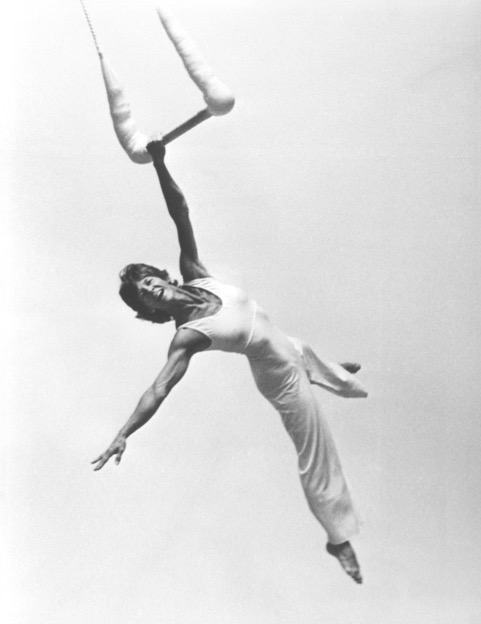Photos by Savage Photography
The earth could not contain Terry, so she took to the sky. And when circumstances made it impossible for her to fly anymore, she overcame her terrestrial uncertainties like some creative shapeshifter, until finally she transformed into a brilliant light. —Adele Prandini
 Terry Ann Sendgraff, dance pioneer, matriarch of aerial dance, visionary artist, and deeply influential teacher transitioned peacefully in her home in Oakland, California on September 6, 2019. She was 85 years old.
Terry Ann Sendgraff, dance pioneer, matriarch of aerial dance, visionary artist, and deeply influential teacher transitioned peacefully in her home in Oakland, California on September 6, 2019. She was 85 years old.
An icon in the San Francisco Bay Area, Terry influenced the fields of performance, improvisation, and aerial dance. While she has been called the “mother of aerial dance” because of her impact on so many aerial artists, Terry’s reach extends nationally and internationally, and can be felt in the bodies of artists, friends, and colleagues across all disciplines. For those of us in the Bay Area who were making work from the ’70s to the ’90s, there is scarcely one who was not directly or indirectly touched by her work.
Terry had a spark like a mischievous child delighted with life, pleased with her body, always curious, playing, sensing. Master of the present moment, Terry was an embodied sage, a pilot of the flying body who taught hundreds to take flight. She taught women to walk tall—on stilts and in their heart and in the streets. No one is more responsible for the Bay Area as home base for aerial dance than Terry Sendgraff. —Keith Hennessy (Circo Zero)
Terry was born on October 12, 1933 in Ft. Myers, Florida. It was there, in the warm winds of southwest Florida, where her desire to dance and to fly was first ignited. Terry earned her BA in Recreation from Pennsylvania State University in 1955 and fashioned a career in both dance and gymnastics. She was involved in crafting the earliest national standards for competitive gymnastics for girls and women, earned her MA in Dance from the University of Colorado, Boulder, and coached women’s gymnastics and taught dance at Arizona State University. During her studies, Terry’s exposure to the work of Alwin Nikolais, José Limón, Charles Weidman, and Merce Cunningham were a great inspiration, nourishing her developing aesthetic.
Terry’s work has been prolific, impressive, beautiful, often hilarious, sometimes understated, sometimes breathtakingly spectacular. The sphere of Terry’s influence is enormous; the evidence of her mark, ubiquitous. She was able to shape her passions into a new art form and to generously gift that back to the world, watching its flame catch and burn for a whole generation of artists. —Anne Bluethenthal (ABD/Skywatchers)
 Terry’s was a liberatory arts voice, informed by impeccable technique and fueled by the freedom of improvisation. Although invigorated by the rigor and structure of the forms she was studying, Terry was increasingly drawn to awareness-oriented movement forms, finding the traditional dance and gymnastic canons restrictive. Determined to find her own dance, Terry moved to California where she developed a movement and performance practice, pedagogy, and opus that blended her extensive dance and gymnastics backgrounds with her passion for improvisation and the emerging counterculture of 1970s Bay Area. Terry’s teaching style was influenced by the developing “Motional Improvisation” work of her mentor and lifelong friend Al Wunder.
Terry’s was a liberatory arts voice, informed by impeccable technique and fueled by the freedom of improvisation. Although invigorated by the rigor and structure of the forms she was studying, Terry was increasingly drawn to awareness-oriented movement forms, finding the traditional dance and gymnastic canons restrictive. Determined to find her own dance, Terry moved to California where she developed a movement and performance practice, pedagogy, and opus that blended her extensive dance and gymnastics backgrounds with her passion for improvisation and the emerging counterculture of 1970s Bay Area. Terry’s teaching style was influenced by the developing “Motional Improvisation” work of her mentor and lifelong friend Al Wunder.
Terry was ageless, wise, childlike, and methodical. She introduced me to aerial work and taught me that the magic of the piece is the life that the apparatus reveals to you as you work with it. How you relate to this new creature is what the audience will see and, if done well, will feel its power, magic and choreographic prowess. I remember once I had to jump off a ladder, land in the hoop, and swing high and far not hitting anything on my way back from the swing. With her voice guiding me, off I would go like I had wings! —Kim Epifano (Epiphany Dance)
Years before the term aerial dance was popularized, Terry had a studio full of flying dancers working from her innovative low flying trapezes. She named her work Motivity. Terry is credited with discovering and deploying in performance the single point trapeze that allowed expansive possibilities not seen with parallel rope trapezes. Over time, aerial dance emerged as a popular post-modern dance genre that has grown and taken root as an intrinsic part of the contemporary performing arts vocabulary.
The essence of Motivity, though, was Terry Sendgraff herself. With her keen ability to elicit the gifts and unique voice of each student, she helped them to hone their aesthetic values. She used a system of heightened sensory awareness while on the ground and in the air, a rigor of practice in the present moment that called out the best and the wholeness of her students and colleagues. Motivity was an embodied blend of personal, political, and spiritual.
“…Motivity, stands as the roots and trunk of the aerial dance family tree. Many aerial dancers, like Jo Kreiter (Flyaway Productions), Amelia Rudolph (Project Bandaloop), and Joanna Haigood (Zaccho Dance Theatre), have sprung from the branches of the Sendgraff/Motivity tree.” —Janine Gastineau (2002, Arts Paper of Boulder)
During these years of experimentation, innovation, and community building, Terry was helping to shape a sub-culture through dance in the Bay Area. An out lesbian choreographer, she was able to speak across all sectors as a performer, teacher, and as culture-shaper, galvanizing a generation of performing artists across disciplines.
She left us so much—touched so many of us. I’m a 4’7” woman walking tall. She did that literally; but the meaning behind it was: stand up! I’m trying to live up to that. —Shakiri

While Terry’s choreography ranged from whimsical to profound, and her performance persona from innocent to sophisticated, her audiences were treated to unexpected surprises. Between 1974 and 2007, Terry created over three hundred performances including her celebrated birthday performances (1974-83) and her unprecedented A Year of Sundays (1977-78). Performance venues ranged from a golf course fairway to a proscenium stage. She directed several distinct but related dance companies including Fly By Night (1978-1980)—the first women’s trapeze dancing troupe in the country—and the Motivity Company (throughout the 1980s and beyond).
Long before it was a cultural trend, Terry was gathering up women from all walks of life to participate in her happenings. Whether it was Women Walking Tall or her ongoing improv groups or the countless people she trained on the low flying trapeze, she was bringing people together in site specific works infused with social justice, and the power and beauty of her women identified sensibility. Terry was an absolutely essential part of the dance community for 40 years. She was in love with the color red. —Krissy Keefer (Dance Brigade)
An irrepressible art spirit, Terry Sendgraff kept innovating. In addition to her multi-level trapezes, she was among the first to use bungee cords in dance performances. Struck with breast cancer in 1984, her process, her recovery, and her one-breasted body became the subject of several pieces including one of her most memorable (and acclaimed) works, Hovering (1988). Launching into another performance medium, Terry took up stilt walking at age 57 to create Women Walking Tall (1991-95). Originally a commissioned performance for the Michigan Womyn’s Music Festival, Women Walking Tall expanded to a community project that empowered hundreds of women to walk, dance, and perform on stilts.
Terry Sendgraff was the singularly most creative person I have ever met. She was an artist to her core and to the end of her life, and her vast empathy led her to actually “see” people in their most productive light. —Wendy Diamond
The enthusiasm that met Motivity—both the aerial work and her teaching of sensory awareness, presence, and improvisation—led her to explore more deeply what she called the marriage of the “motional and the emotional,” by earning a master’s degree in Clinical Psychology from John F. Kennedy University in 1986.
What a force Terry was/is! A huge supporter and friend to me and to AXIS Dance Company, she is a huge part of why we kept creating and performing. She started AXIS off on aerial work and we shared the stage with her in her productions many times in our early years. Terry was an under-sung heroine of the air and the dance floor. —Judith Smith (AXIS Dance Company)
Terry Sendgraff received many honors throughout her career, including three Isadora Duncan Dance Awards for Solo Performance (1989), Choreography (2001) and Sustained Achievement (2005). She was a featured artist and faculty member at the Annual International Aerial Dance Festival in Boulder, Colorado (1999-2005). Her career was also chronicled by Jeff Friedman as an oral history for The Legacy Project (1991). She received numerous grant awards, most notably a Choreographer’s Fellowship from the National Endowment for the Arts (1993-1994) and Artist Residencies from the California Arts Council (1993, 1994). In 1990, PBS aired Can You See Me Flying: A Portrait of Terry Sendgraff, by filmmaker Fawn Yacker. A larger than life sized bronze sculpture of Terry is part of a group of sculptures called Dance (1974), created by John Waddell that can be viewed in front of the Herberger Theater Center in Phoenix, Arizona. She published her memoir Can You See Me Flying: Memoir of an Aerial Dance Pioneer in July 2018.
Terry was a visionary artist, a healer, an irrepressible adventurer. She has given us so many gifts but none more powerful than the creative inspiration to awaken our bodies and spirits to the joy of life. —Joanna Haigood (Zaccho Dance Theatre)
Terry will be remembered as a creative choreographer, a brave performer, and as a master teacher. Her gentle and kind guidance allowed so many to blossom physically and emotionally, each encouraged to find their own dance. Countless performance luminaries collaborated or studied with Terry. To name only a handful, the list includes Heather Baer, Anne Bluethenthal, Dudley Brooks, Byron Brown, Joya Cory, Wendy Diamond, Kim Epifano, Debra Floyd, Jill Guillermo-Togawa, Joanna Haigood, Barbara Hammer, Keith Hennessy, Rhodessa Jones, Krissy Keefer, Denise Pate, Adele Prandini, Sharon Page Ritchie, Priscilla Regalado, Shakiri, Judith Smith, Nancy Smith, Jim Tyler, Al Wunder, Nina Wise, Ruth Zaporah. Some of Terry’s musical and visual collaborators were Gwen Jones, Kayla Kirsch, Jeannine Chappell, Karen Vogel, Carolyn Brandy, Debbie Fier, and Jennifer Berezan.
Terry is survived by her loving wife, partner, and best friend of nearly 35 years, Aileen Moffitt. She will long be remembered and celebrated by a large group of loving friends, colleagues, collaborators, dancers, and students.
Scholarships in Terry’s name are being established for aerial festivals in Colorado and San Francisco. Donations can be made to coloradogives.org/TerrySendgraff, (Frequent Flyers International Aerial Dance Festival), zaccho.org (San Francisco Aerial Arts Festival), or the charity of your choice. For information regarding the fund or for details of Celebration of Life to be held in November, please contact terrysendgraffmemorial@gmail.com.
This article appeared in the November 2019 issue of In Dance.


